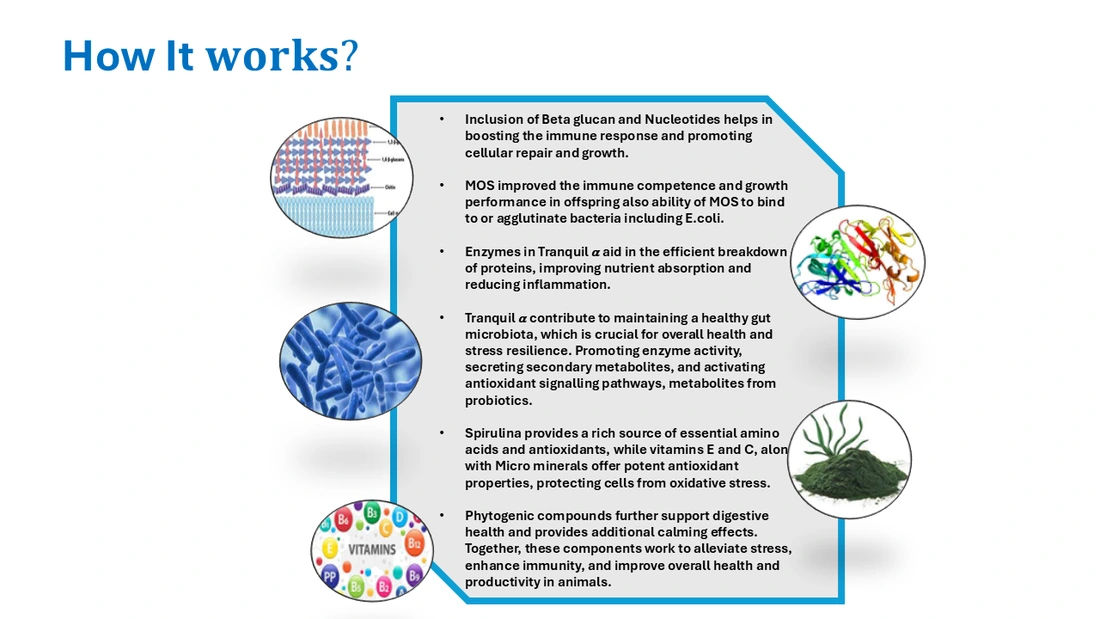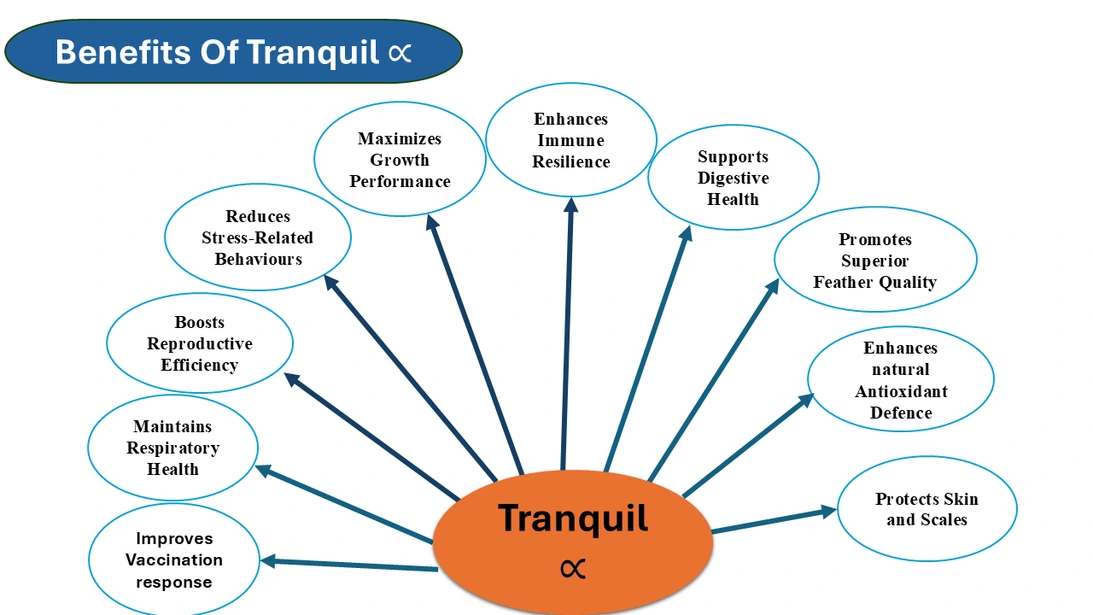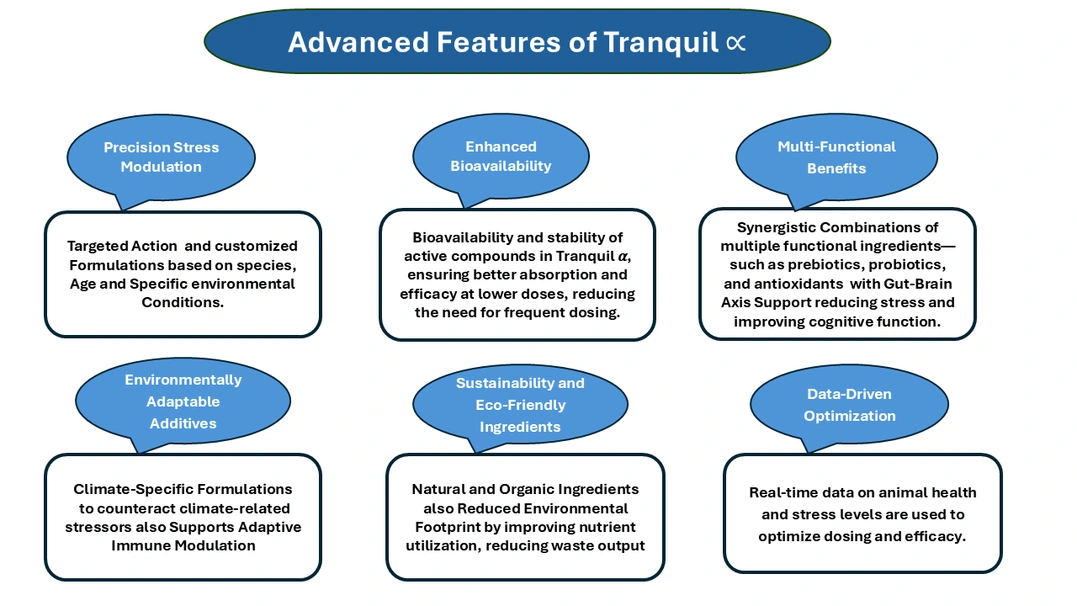
Stress in Poultry
A chicken utilises various behavioural and metabolic mechanisms to maintain a homeostatic internal environment and ensure normal physiological function. A deviation from this homeostatic condition is called “stress”. Commercially farmed chickens are subjected to conditions that constantly challenge their ability to maintain this homeostatic state and chicken stress has a significant effect on the overall health and productivity of a flock. It is therefore important to understand the factors that contribute to stress. Identifying and managing these factors is a critical part of successful poultry production.
 Temperature stress – Heat and cold
Temperature stress – Heat and coldChickens have a body temperature of 41°C and aim to maintain their body temperature within a thermo-neutral zone (TNZ). Chickens in a commercial environment have limited mechanisms for temperature control and are therefore susceptible to extreme cold or heat, or a dramatic change from one to the other.
Heat stress occurs during hot conditions when birds experience difficulties in achieving a balance between body heat production and body heat loss and the body temperatures tend to move outside of the TNZ. Maintaining a body temperature with the TNZ requires behavioural changes, including panting, that demands energy and alters blood pH. Another response is to minimise body heat production by reducing feed intake and consequently the heat increment of digestion. Both these responses have negative effects on production.
Environmental stress – Air, light and litter
A commercial chicken’s environment typically refers to its housing. Housing, or environmental, conditions include factors such as air, light and litter (bedding) quality. Poor ventilation can lead to poor quality air (high levels of CO2 and ammonia) and heat build-up which will stress the bird. Chickens in deep-litter systems are in constant contact with their bedding and the condition of the litter will affect the bird’s comfort and wellbeing. Litter condition is a product of feed, water and ventilation management, as well as stocking density and bedding material selection (and its absorbency). Artificial lighting (duration) and light intensity are “foreign” to chickens and can place the bird under undue stress if not managed correctly.
Physiological stress – Production and reproduction
The activities surrounding breeding and laying an egg are stressful, especially with the first season of maturity for either sex. Laying of the first egg for a hen can be difficult, both in the hormone changes that occur and in the physical exertion it requires. Most mortalities due to diseases such as Mareks occur right before or right after sexual maturity due to the stress that these activities place on the bird.

Pathological stress – Disease
Exposure
to infectious agents is a common cause of stress. When sub-clinical infections
due to poor bio-security and sanitation persist then excessive activation of
the chicken’s immune system will result in a condition known as immunological
stress. This condition results in a series of changes in the nutrient
metabolism induced by mediators of the immune response and production will
suffer.
Social stress – Housing
Chickens
are social animals, and they will establish a hierarchy, or pecking order,
within a flock. Moving or swopping birds will disrupt this hierarchy leading to
stress and a consequent drop in production. Overcrowding of chickens due to the
incorrect stocking densities being adopted or improper house (equipment)
lay-out will also result in stress.
Physical stress – Handling
Chickens
are a prey species so naturally if caught and picked up they become stressed.
Harsh handling of chickens during vaccination, weighing, transfer, harvest and
transportation will all contribute towards stressing the bird
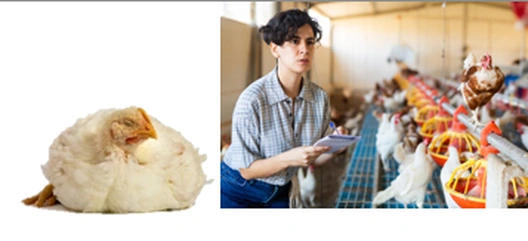
Animal
Response to Heat Stress:
Behavioural Changes
- Panting: Birds will pant to increase evaporative cooling from the respiratory tract.
- Spreading Wings: Chickens often spread their wings away from their bodies to dissipate heat.
- Reduced Feed Intake: Heat-stressed birds tend to eat less, leading to reduced growth and productivity.
- Increased Water Consumption: Birds drink more water to cool down and maintain hydration.
- Lethargy: Reduced physical activity is common as birds try to conserve energy and minimize heat production.
- Crowding in Cooler Areas: Birds will gather in shaded or cooler parts of their environment.
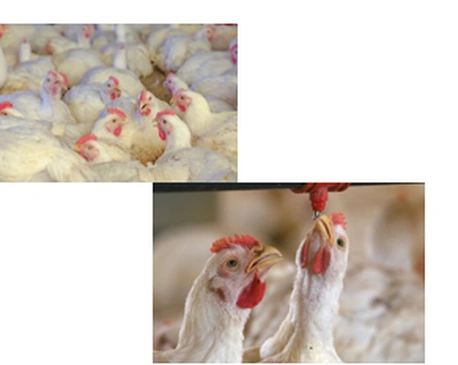
Physiological Changes
- Elevated Body Temperature: Core body temperature rises, which can lead to hyperthermia if unchecked.
- Increased Respiration Rate: Higher respiration rates help with evaporative cooling but can lead to respiratory alkalosis.
- Altered Blood Flow: Blood flow is redirected towards the skin and extremities to facilitate heat loss.
- Electrolyte Imbalance: Increased panting and water consumption can disrupt the balance of electrolytes like sodium, potassium, and chloride.
- Decreased Egg Production: Heat stress negatively impacts laying hens, leading to reduced egg production and quality.
- Impaired Immune Function: Chronic heat stress can weaken the immune system, making birds more susceptible to diseases.
- Reduced Growth and Weight Gain: Lower feed intake and metabolic disturbances result in slower growth and weight gain.

Effects Of Stress:
HS can cause severe losses, including a decrease in body
weight (Mashaly
et al., 2004), an increased mortality rate (Khan
et al., 2011), negatively affects growth rate, egg number, egg size and egg quality
(Azzam
et al., 2019), deleterious effects on immunity and feed utilization with increasing
of oxidative
stress in birds (Wolfenson
et al., 2001; Lara
and Rostagno, 2013).
Changes in the intestinal
microbiome
Due to reduced feed intake and
impaired intestinal function, the presence and activity of the commensal
microbiota can also be modified. Heat stress can lead to reduced populations of
beneficial microbes, boost the growth of potential pathogens leading to
dysbiosis and necrotic enteritis. Moreover, Akinyemi
et al. (2020) pronounced
that Gut microbiota in poultry birds is significantly affected while exposed to
excessive ambient temperatures and heat stress. Additionally, it permits the
propagation of pathogenic bacteria, including Salmonella, E. coli, and TBA, in the intestinal
microbiota (Kammon
et al., 2019).
Changes in intestinal permeability
Several studies indicate that both acute and chronic heat stress increase gut permeability, not only by lowering feed intake, but also by increasing intestinal oxidative stress and disrupting the expression of tight junction proteins. Heat stress can lead to ‘loose junctions’ in the gut, allowing easier access for bacteria to enter the bloodstream. Lowering the brooding temperature to 31-330C reduced this stress. The intestinal tract of poultry is highly susceptible to stressors, such as HS. This can lead to intestinal mucosa damage, gut microbiota changes, and gut dysbiosis (Shi et al., 2019; Tian et al., 2016).
Heat and oxidative stress in the gut result in cell injury and apoptosis. When the tight junction barrier is compromised, luminal substances leak into the bloodstream, which constitutes the condition known as “leaky gut”. This includes the translocation of pathogenic bacteria, including zoonotic pathogens (e.g. Salmonella and Campylobacter); consequently, a higher risk of contamination of food products can be expected.

Changes
in Chicken Meat Quality
Stress affects quality of chickens
such as meat colour, tenderness. If temperature reaches 350C or below 70C meat production and fat
deposition of broilers will decrease.
Affects
Egg Shell Thickness
The birds eat less in high
temperature and the onset of heat stress. There increased respiration rate
causes CO2
expiration. The blood becomes more alkaline and in order to restore the acid
base imbalance HCO3
required, making it. Less available for eggshell calcification (CaCO3). These are two reasons why shell
becomes thinner.
Endotoxins
In stress situations, the
intestinal barrier function is impaired, allowing the passage of endotoxins
into the blood stream. When LPS are detected by the immune system either in the
blood or in the basolateral side of the intestine, inflammation and changes in
the gut epithelial structure and functionality occur.
Impaired
gut function
In the gastrointestinal tract,
oxidative stress and the consequent tissue damage, lower feed digestion and
absorption, increase intestinal permeability and modify the microbiome.
Numerous reports have informed DM
digestibility was reduced in laying hens under HS conditions (Kim
et al., 2020), and reductions in nitrogen digestibility or CP ranged between 10%
and 1.5% under HS conditions (Attia
et al., 2022).

Need for Stress Relief Feed additive
The demand for stress-relief feed additives is likely to increase as livestock industries face growing challenges related to animal welfare, environmental pressures, and consumer expectations. Advanced features of these additives will need to address these evolving needs effectively.
- Increased Environmental Stressors: As climate change leads to more extreme weather conditions, animals will face heightened environmental stress. Feed additives that can mitigate heat stress, cold stress, and other environmental challenges will be increasingly essential.
- Intensified Production Systems: With the push for higher productivity in confined production systems, animals will experience more stress due to overcrowding, limited space, and high stocking densities. Additives that enhance resilience in these high-pressure environments will be in demand.
- Consumer-Driven Welfare Standards: Growing consumer concern for animal welfare will drive the need for additives that can reduce stress and improve the overall well-being of animals. Products that can demonstrably reduce stress will align with ethical farming practices.
- Sustainability and Resource Efficiency: As the industry moves toward more sustainable practices, stress-relief additives that also enhance feed efficiency and reduce waste will be critical.
- Health and Disease Management: The increasing prevalence of diseases due to stress will necessitate feed additives that not only reduce stress but also support immune function and overall health.

Tranquil 𝛼
Tranquil 𝛼 is
a revolutionary feed additive meticulously crafted to transform broiler farming
by effectively managing stress. Harnessing the power of natural calming agents
and cutting-edge formulations, Tranquil 𝛼
ensures your broilers thrive in a stress-free environment. By reducing
stress-related behaviors and enhancing overall well-being, it optimizes feed
efficiency and supports robust growth, improving the color stability and
quality of meat.
